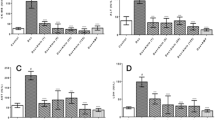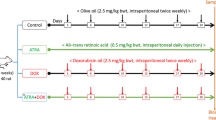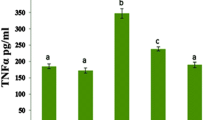Abstract
Doxorubicin (DOX), a potent chemotherapeutic agent, is widely used for the treatment of various malignancies. However, its clinical uses are limited due to its dose-dependent adverse effects particularly cardiac and testicular toxicities. DOX-induced toxicity is mainly due to the induction of oxidative stress. Atorvastatin (ATV), a 3-hydroxy 3-methyl glutaryl coenzyme A reductase inhibitor, with lipid-lowering activity, acts as an antioxidant at lower doses. It possesses pleiotropic effects independent of cholesterol-lowering property usually shown at lower doses, which include antioxidant and anti-inflammatory activities. The present study was aimed to investigate the possible protection exerted by atorvastatin against oxidative stress and DNA damage induced by DOX in the heart and testes of mice. The protective role of ATV in the heart and testes of DOX-treated mice was evident from the amelioration of oxidative stress, DNA and cellular damage. The present study clearly indicates that ATV offers a significant protection against DOX-induced oxidative stress and DNA damage in the heart and testes of mice.






Similar content being viewed by others
Abbreviations
- DOX:
-
Doxorubicin
- ATV:
-
Atorvastatin
- HMG-CoA:
-
3-Hydroxy 3-methyl glutaryl coenzyme A
- PBMN:
-
Peripheral blood micronucleus
- LDL:
-
Low-density lipoprotein
- CMC:
-
Carboxy methyl cellulose
- H&E:
-
Hematoxylin and eosin
- DMSO:
-
Dimethylsulphoxide
- NMPA:
-
Normal melting point agarose
- LMPA:
-
Low melting point agarose
- EDTA:
-
Ethylenediamine tetraacetic acid
- HBSS:
-
Hank’s balanced salt solution
- MDA:
-
Malondialdehyde
- GSH:
-
Reduced glutathione
- TL:
-
Tail length
- TM:
-
Tail moment
- OTM:
-
Olive tail moment
- % DNA:
-
% DNA in tail
- HDL:
-
High-density lipoprotein
References
Aiken MJ, Suhag V, Garcia CA, Acio E, Moreau S, Priebat DA, Chennupati SP, Van Nostrand D (2009) Doxorubicin-induced cardiac toxicity and cardiac rest gated blood pool imaging. Clin Nucl Med 34:762–767
Alkreathy H, Damanhouri ZA, Ahmed N, Slevin M, Ali SS, Osman A-MM (2010) Aged garlic extract protects against doxorubicin-induced cardiotoxicity in rats. Food Chem Toxicol 48:951–956
Almuti K, Rimawi R, Spevack D, Ostfeld RJ (2006) Effects of statins beyond lipid lowering: potential for clinical benefits. Int J Cardiol 109:7–15
Atessahin A, Turk G, Karahan I, Yilmaz S, Ceribasi AO, Bulmus O (2006) Lycopene prevents adriamycin-induced testicular toxicity in rats. Fertil Steril 85(Suppl 1):1216–1222
Aviram M, Rosenblat M, Bisgaier CL, Newton RS (1998) Atorvastatin and gemfibrozil metabolites, but not the parent drugs, are potent antioxidants against lipoprotein oxidation. Atherosclerosis 138:271–280
Aydin S, Uzun H, Sozer V, Altug T (2009) Effects of atorvastatin therapy on protein oxidation and oxidative DNA damage in hypercholesterolemic rabbits. Pharmacol Res 59:242–247
Beillerot A, Dominguez JC, Kirsch G, Bagrel D (2008) Synthesis and protective effects of coumarin derivatives against oxidative stress induced by doxorubicin. Bioorg Med Chem Lett 18:1102–1105
Brown CD, Forman CL, McEuen SF, Miller MG (1994) Metabolism and testicular toxicity of 1,3-dinitrobenzene in rats of different ages. Fundam Appl Toxicol 23:439–446
Dadhania VP, Tripathi DN, Vikram A, Ramarao P, Jena GB (2010) Intervention of alpha-lipoic acid ameliorates methotrexate-induced oxidative stress and genotoxicity: a study in rat intestine. Chem Biol Interact 183:85–97
Damrot J, Nubel T, Epe B, Roos WP, Kaina B, Fritz G (2006) Lovastatin protects human endothelial cells from the genotoxic and cytotoxic effects of the anticancer drugs doxorubicin and etoposide. Br J Pharmacol 149:988–997
Davignon J (2004) Beneficial cardiovascular pleiotropic effects of statins. Circulation 109:III39–III43
DeAtley SM, Aksenov MY, Aksenova MV, Harris B, Hadley R, Cole Harper P, Carney JM, Butterfield DA (1999) Antioxidants protect against reactive oxygen species associated with adriamycin-treated cardiomyocytes. Cancer Lett 136:41–46
Elberry AA, Abdel-Naim AB, Abdel-Sattar EA, Nagy AA, Mosli HA, Mohamadin AM, Ashour OM (2010) Cranberry (Vaccinium macrocarpon) protects against doxorubicin-induced cardiotoxicity in rats. Food Chem Toxicol 48:1178–1184
Fan GC, Zhou X, Wang X, Song G, Qian J, Nicolaou P, Chen G, Ren X, Kranias EG (2008) Heat shock protein 20 interacting with phosphorylated Akt reduces doxorubicin-triggered oxidative stress and cardiotoxicity. Circ Res 103:1270–1279
Giri SN, Al-Bayati MA, Du X, Schelegle E, Mohr FC, Margolin SB (2004) Amelioration of doxorubicin-induced cardiac and renal toxicity by pirfenidone in rats. Cancer Chemother Pharmacol 53:141–150
Granados-Principal S, Quiles JL, Ramirez-Tortosa CL, Sanchez-Rovira P, Ramirez-Tortosa MC (2010) New advances in molecular mechanisms and the prevention of adriamycin toxicity by antioxidant nutrients. Food Chem Toxicol 48:1425–1438
Hamaguchi T, Azuma J, Harada H, Takahashi K, Kishimoto S, Schaffer SW (1989) Protective effect of taurine against doxorubicin-induced cardiotoxicity in perfused chick hearts. Pharmacol Res 21:729–734
Harangi M, Seres I, Varga Z, Emri G, Szilvassy Z, Paragh G, Remenyik E (2004) Atorvastatin effect on high-density lipoprotein-associated paraoxonase activity and oxidative DNA damage. Eur J Clin Pharmacol 60:685–691
Holden HE, Majeska JB, Studwell D (1997) A direct comparison of mouse and rat bone marrow and blood as target tissues in the micronucleus assay. Mutat Res 391:87–89
Jotti A, Paracchini L, Perletti G, Piccinini F (1992) Cardiotoxicity induced by doxorubicin in vivo: protective activity of the spin trap alpha-phenyl-tert-butyl nitrone. Pharmacol Res 26:143–150
Kaklamani VG, Gradishar WJ (2003) Epirubicin versus doxorubicin: which is the anthracycline of choice for the treatment of breast cancer? Clin Breast Cancer 4(Suppl 1):S26–S33
Kishikawa H, Tateno H, Yanagimachi R (1999) Chromosome analysis of BALB/c mouse spermatozoa with normal and abnormal head morphology. Biol Reprod 61:809–812
Li W, Nie S, Xie M, Chen Y, Li C, Zhang H (2010) A major green tea component, (-)-epigallocatechin-3-gallate, ameliorates doxorubicin-mediated cardiotoxicity in cardiomyocytes of neonatal rats. J Agric Food Chem (in press)
Lowry OH, Rosebrough NJ, Farr AL, Randall RJ (1951) Protein measurement with the Folin phenol reagent. J Biol Chem 193:265–275
Mason RP, Walter MF, Day CA, Jacob RF (2006) Active metabolite of atorvastatin inhibits membrane cholesterol domain formation by an antioxidant mechanism. J Biol Chem 281:9337–9345
Moron MS, Depierre JW, Mannervik B (1979) Levels of glutathione, glutathione reductase and glutathione S-transferase activities in rat lung and liver. Biochim Biophys Acta 582:67–78
Ohkawa H, Ohishi N, Yagi K (1979) Assay for lipid peroxides in animal tissues by thiobarbituric acid reaction. Anal Biochem 95:351–358
Pai VB, Nahata MC (2000) Cardiotoxicity of chemotherapeutic agents: incidence, treatment and prevention. Drug Saf 22:263–302
Pereverzeva E, Treschalin I, Bodyagin D, Maksimenko O, Langer K, Dreis S, Asmussen B, Kreuter J, Gelperina S (2007) Influence of the formulation on the tolerance profile of nanoparticle-bound doxorubicin in healthy rats: focus on cardio- and testicular toxicity. Int J Pharm 337:346–356
Prahalathan C, Selvakumar E, Varalakshmi P (2004) Remedial effect of DL-α-lipoic acid against adriamycin induced testicular lipid peroxidation. Mol Cell Biochem 267:209–214
Prahalathan C, Selvakumar E, Varalakshmi P (2006) Lipoic acid modulates adriamycin-induced testicular toxicity. Reprod Toxicol 21:54–59
Prahalathan C, Selvakumar E, Varalakshmi P (2006) Modulatory role of lipoic acid on adriamycin-induced testicular injury. Chem Biol Interact 160:108–114
Rashikh A, Najmi AK, Akhtar M, Mahmood D, Pillai KK, Ahmad SJ (2011) Protective effects of aliskiren in doxorubicin-induced acute cardiomyopathy in rats. Hum Exp Toxicol 30:102–109
Riad A, Bien S, Westermann D, Becher PM, Loya K, Landmesser U, Kroemer HK, Schultheiss HP, Tschope C (2009) Pretreatment with statin attenuates the cardiotoxicity of doxorubicin in mice. Cancer Res 69:695–699
Riad A, Du J, Stiehl S, Westermann D, Mohr Z, Sobirey M, Doehner W, Adams V, Pauschinger M, Schultheiss HP, Tschope C (2007) Low-dose treatment with atorvastatin leads to anti-oxidative and anti-inflammatory effects in diabetes mellitus. Eur J Pharmacol 569:204–211
Schrott HG, Knapp H, Davila M, Shurzinske L, Black D (2000) Effect of atorvastatin on blood lipid levels in the first 2 weeks of treatment: a randomized, placebo-controlled study. Am Heart J 140:249–252
Sharma H, Pathan RA, Kumar V, Javed S, Bhandari U (2011) Anti-apoptotic potential of rosuvastatin pretreatment in murine model of cardiomyopathy. Int J Cardiol 150:193–200
Singh NP, McCoy MT, Tice RR, Schneider EL (1988) A simple technique for quantitation of low levels of DNA damage in individual cells. Exp Cell Res 175:184–191
Singh G, Singh AT, Abraham A, Bhat B, Mukherjee A, Verma R, Agarwal SK, Jha S, Mukherjee R, Burman AC (2008) Protective effects of Terminalia arjuna against doxorubicin-induced cardiotoxicity. J Ethnopharmacol 117:123–129
Tan HH, Porter AG (2009) DNA methyltransferase I is a mediator of doxorubicin-induced genotoxicity in human cancer cells. Biochem Biophys Res Commun 382:462–467
Trivedi PP, Kushwaha S, Tripathi DN, Jena GB (2010) Evaluation of male germ cell toxicity in rats: correlation between sperm head morphology and sperm comet assay. Mutat Res 703:115–121
Trivedi PP, Kushwaha S, Tripathi DN, Jena GB (2011) Cardioprotective effects of hesperetin against doxorubicin-induced oxidative stress and DNA damage in rat. Cardiovasc Toxicol 11:215–225
Trivedi PP, Tripathi DN, Jena GB (2011) Hesperetin protects testicular toxicity of doxorubicin in rat: role of NFkappaB, p38 and caspase-3. Food Chem Toxicol 49:838–847
Vikram A, Tripathi DN, Ramarao P, Jena GB (2008) Intervention of D-glucose ameliorates the toxicity of streptozotocin in accessory sex organs of rat. Toxicol Appl Pharmacol 226:84–93
Wang J, Xu J, Zhou C, Zhang Y, Xu D, Guo Y, Yang Z (2012) Improvement of arterial stiffness by reducing oxidative stress damage in elderly hypertensive patients after 6 months of atorvastatin therapy. J Clin Hypertens (Greenwich) 14:245–249
Wassmann S, Laufs U, Muller K, Konkol C, Ahlbory K, Baumer AT, Linz W, Bohm M, Nickenig G (2002) Cellular antioxidant effects of atorvastatin in vitro and in vivo. Arterioscler Thromb Vasc Biol 22:300–305
Weiss RB (1992) The anthracyclines: will we ever find a better doxorubicin? Semin Oncol 19:670–686
Werner N, Nickenig G, Laufs U (2002) Pleiotropic effects of HMG-CoA reductase inhibitors. Basic Res Cardiol 97:105–116
Wyrobek AJ, Bruce WR (1975) Chemical induction of sperm abnormalities in mice. Proc Natl Acad Sci U S A 72:4425–4429
Yeh YC, Liu TJ, Wang LC, Lee HW, Ting CT, Lee WL, Hung CJ, Wang KY, Lai HC (2009) A standardized extract of Ginkgo biloba suppresses doxorubicin-induced oxidative stress and p53-mediated mitochondrial apoptosis in rat testes. Br J Pharmacol 156:48–61
Zhang W, Li Q, Wang L, Yang X (2008) Simvastatin ameliorates glomerulosclerosis in adriamycin-induced-nephropathy rats. Pediatr Nephrol 23:2185–2194
Zhou Q, Liao JK (2010) Pleiotropic effects of statins. Basic research and clinical perspectives. Circ J 74:818–826
Acknowledgments
We wish to acknowledge the financial assistance received from National Institute of Pharmaceutical Education and Research (NIPER), S.A.S. Nagar for this work. The authors would like to acknowledge Biochem Pharmaceutical Industries Ltd., Mumbai, India and Intas Pharmaceuticals Ltd., Ahmedabad, India for benevolently granting the gift samples of ATV Calcium and doxorubicin, respectively.
Conflict of interest
None.
Author information
Authors and Affiliations
Corresponding author
Rights and permissions
About this article
Cite this article
SVVS, R., Trivedi, P.P., Kushwaha, S. et al. Protective role of atorvastatin against doxorubicin-induced cardiotoxicity and testicular toxicity in mice. J Physiol Biochem 69, 513–525 (2013). https://doi.org/10.1007/s13105-013-0240-0
Received:
Accepted:
Published:
Issue Date:
DOI: https://doi.org/10.1007/s13105-013-0240-0




